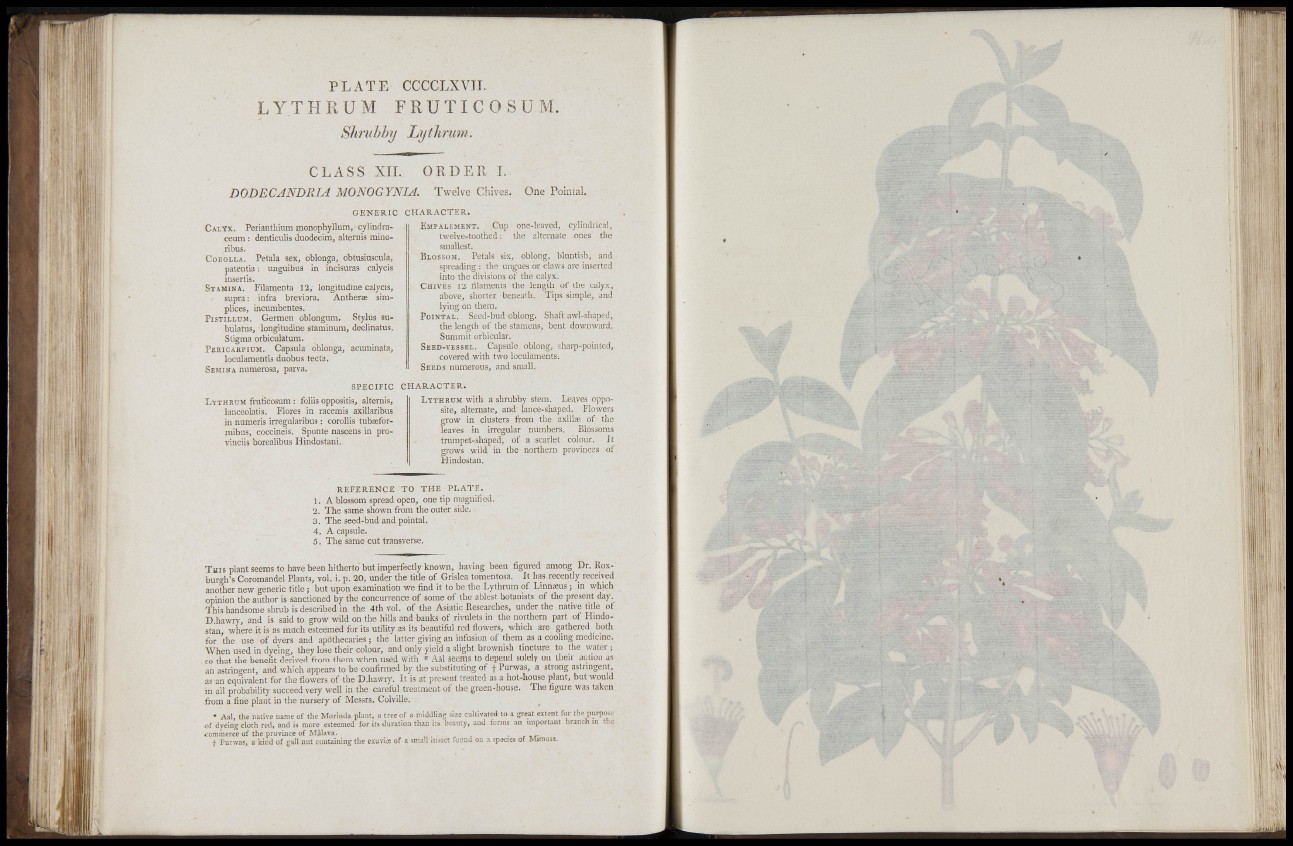
T
â j i ï
I
> • :: I
I . - 1
I, :
•iM'.iil^
Í
P L A T E CCCCLXVIT.
L Y T H R U M F R U T I C O S U
Shrubby Lythrum.
C L A S S XII. ORDER I.
DODECANDRIA MONOGYNIA. Twelve Chives. One Pointai.
G E N E R I C CHARACTER.
CALYX. Periantlnum monophyllum, cylindraceum
: denticulis duodecim, alternis minolibus.
COKOLLA. Pétala sex, oblonga, obtusiuscula,
patentia : unguibus in incisuras calycis
insertis.
STAMINA. Filamenta 12, longitudine calycis,
supra: infra breviora. Antherse simplices,
incumbentes.
PISTILLUM. Germen oblongum. Stylus subulatus,
longitudine staminura, declinatus.
Stigma orbiculatum.
PERICARPIUM. Capsula oblonga, acuminata,
loculamentis duobus tecta.
SEMINA numerosa, parva.
one-leaved, cylindrical,
the alternate ones the
EMPALEMENT. Cup
twelve-toothed :
smallest.
BLOSSOM. Petals six, oblong, bluntish, and
spreading : the ungues or claws are inserted
into the divisions of the calyx.
CHIVES 12 filaments the length of the calyx,
above, shorter beneath. Tips simple, and
lying on them.
POINTAL. Seed-bud oblong. Shaft awl-shaped,
the length of the stamens, bent downward.
Summit orbicular.
SEED-VESSEL. Capsule oblong, sharp-pointed,
covered with two loculaments.
SEEDS numerous, and small.
S P E C I F I C CHARACTER.
LYTHEUM fruticosum : foliis oppositis, alternis,
lanceolatis. Flores in racemis axillaribus
in numeris irregularibus : corollis tubaeformibus,
coccineis. Sponte nascens in provinciis
borealibus Hindostani.
L'iTHRUM with a shrubby stem. Leaves opposite,
alternate, and lance-shaped. Flowers
grow in clusters from the axillae of the
leaves in irregular numbers. Blossoms
trumpet-shaped, of a scarlet colour. It
grows wild in the northern provinces of
Hindostán.
R E F E R E N C E TO THE PLATE.
1. A blossom spread open, one tip magnitied.
2. The same shown from the outer side.
3. The seed-bud and pointal.
4. A capsule.
5. The same cut transverse.
T H I S plant seems to have been hitherto but imperfectly known, having been figured among Dr. Koxburo
h's Coromandel Plants, vol. i. p. 20, under the title of Grislea tomentosa. It has recently received
anodier new generic title; but upon examination we find it to be the Lythrum of Linnseus ; in which
opinion the author is sanctioned by the concurrence of some of the ablest botanists of tlie present day.
This handsome shrub is described in the 4th vol. of the Asiatic Researches, under the native title ot
D hawry, and is said to grow wild on the hills and banks of rivulets in the northern part of Hindostán
where it is as much esteemed for its utility as its beautiful red flowers, xvhich are gathered both
for the use of dvers and apothecaries ; the latter giving an infusion of Ihem as a cooling medicine.
When used in dyeing, they lose their colour, and only yield a slight brownish tincture to the water ;
-=0 that the benefit derived from Üiem when used with * Aal seems to depend solely on their action as
an astrin<Tent, and which appears to be confirmed by the substituting of f Purwas, a strong astringent,
as an equivalent for the flowers of the D.hawr)-. It is at present treated as a hot-house plant, but would
in all probability succeed very well in the careful treaimeat of tíie green-house. The figure was taken
from a fine plant in the nursery of Messrs. ColviUe.
* Aal, the native name of the Morinda plant, a tree of a middling sire cultivated to a great extent for the piirpow
of dyeing cloth red, and is more esteemed for its duration than its beauty, and forms an important brands m tl:a
commerce of the province of Malava. ,
t Purwas, a kind of gall nut containing the exuvis of a small insect found or. a spocies of Mimosa.
•lü--. 'í
I
li
•'.ri!.!
'¡i-
; I
'i
r .. •
( ••í^N'